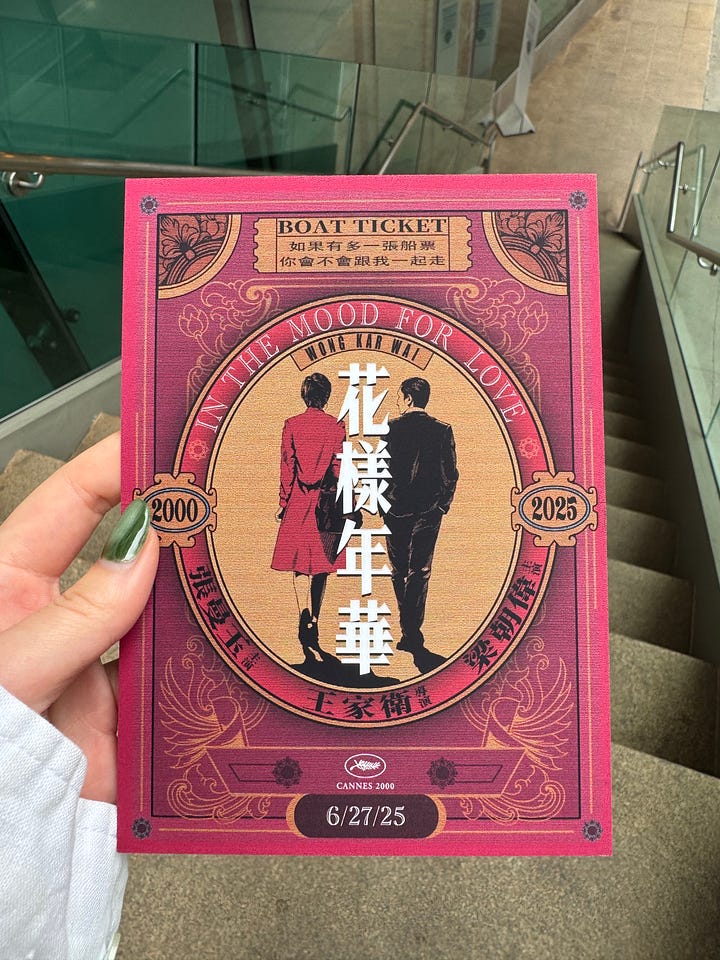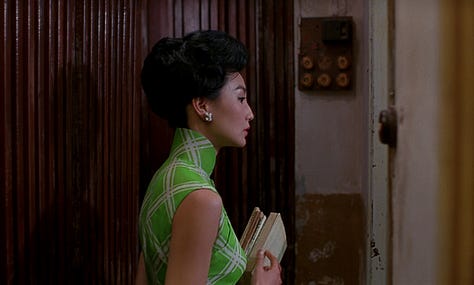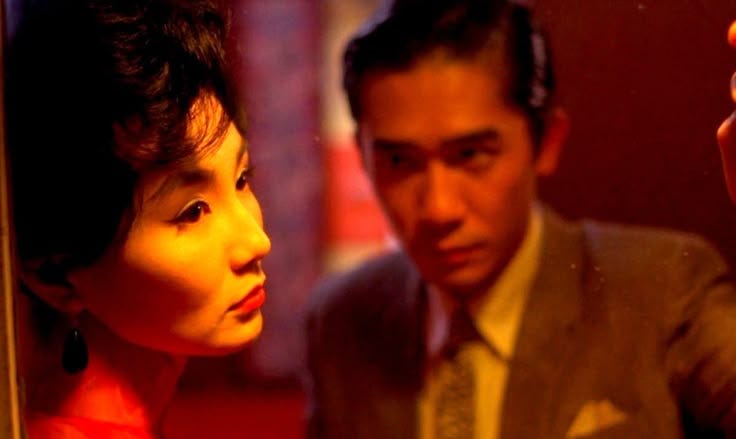A couple of days ago, I went to see the 25th anniversary re-release of In the Mood for Love. In his magnum opus, director Wong Kar-Wai transports us to the world of 1960’s Hong Kong, where the protagonists, Su Li-Zhen and Chow Mo-Wan, move into the same building on the same day. From then on, their lives increasingly intertwine as they discover their spouses’ infidelity and develop a deep connection of their own, becoming more than just next-door neighbors.
In this re-release, we were in for a special treat in the form of a 9-minute coda called In the Mood for Love 2001. The short had only been shown once before, at the 2001 Cannes Film Festival, and portrays the two characters in an alternate universe, one as a convenience store owner and the other a frequent patron.


The Chinese name of In the Mood for Love (ITMFL) is 花样年华 or “full bloom of youth,” which captures the ephemeral nature of beauty, love and youth. But it’s not so much of a coming-of-age story as it is a reflection of that love that somehow drifts just beyond our reach. It’s la douler exquise, or the exquisite pain, that arises when we regretfully realize that we might have been so close to a happy ending.
Certain elements of the film, such as the color green and ghostly presence of the two characters after separating reminds me of the classic American novel The Great Gatsby. From both of these works, one thing is for sure — nothing haunts us more than the love we did not pursue.
What if?
Like any tale of star-crossed lovers, the movie hinges on the central question of “what if?”
What if you hadn’t gotten married?
What if there was an extra ticket, would you come with me?
What if I met you in a different time or place?
However, at a certain point, the situation reaches a boiling point and a decision must be made. Humans aren’t built to handle gray area situations for very long and eventually the need for certainty becomes so overwhelming that one of them tips the scale.
For Daisy, Gatsby’s love interest, his lack of physical presence due to the war makes her doubt her decision to wait for him. She starts simultaneously feeling “the pressure of the world outside” and that “something within her was crying for a decision.” So she gets married to Tom Buchanan. For Chow, he figures that Su won’t leave her husband. “So I’d rather go away,” he laments. So he departs for Singapore.
That era has passed. Nothing that belonged to it exists anymore.
Then the relationship becomes a thing of the past. The past is the past. They say that we never step in the same river twice because everything is constantly changing. The people that they were back then are not the same people they are now. To try to repeat the past would be like planting dead flowers and expecting them to bloom again. Still, we can’t help but try.
Going green
Jay Gatsby, from The Great Gatsby, famously proclaims, “Can’t repeat the past? Why of course you can!” Which is why he buys the house across the bay from Daisy, so that every night he can stare at the green light that glows at the end of her dock. To Gatsby, the green light represents his dream of reuniting with his beloved Daisy, and “the orgastic future that year by year recedes before us.” He’s so close he can see the light, yet his dream remains untouchable; it’s separated by the chasm of not just water, but of all the weight of the decisions he and Daisy have made since they last met.



Similarly, in ITMFL, green represents longing and unfulfilled wishes. Su wears the same green qipao with diamonds whenever she’s looking for Chow but cannot find him. In one of the last scenes, she’s wearing green when she goes back to the room that they used to write in. But she’s too late — he’s already left for Singapore. Once again, she seeks but does not find him. Only this time, she may never find him again.
He remembers those vanished years. As though looking through a dusty window pane, the past is something he could see, but not touch. And everything he sees is blurred and indistinct.
Going ghost
In Gatsby’s case, he does meet Daisy again, almost five years later. In an attempt to win her over, Gatsby throws elaborate parties and silk shirts at her to convince her of his newfound wealth. But it’s unclear whether Gatsby is in love with Daisy or his grandiose idea of her.
As Gatsby is giving Daisy a house tour, Nick, the protagonist and cousin of Daisy, opines that “There must have been moments even that afternoon when Daisy tumbled short of his dreams — not through her own fault but because of the colossal vitality of his illusion.” Gatsby’s illusion of Daisy still haunts him and he makes matters worse for himself by elevating her to a god-like status in his mind. Ultimately, not even Daisy can compete with the fantasy: “No amount of fire or freshness can challenge what a man will store up in his ghostly heart.”
Unlike Daisy and Gatsby, Su and Chow don’t meet again. However, they maintain an eery presence in each other’s lives through their ghostly points of contact. Su visits Singapore and goes into the room of Chow. She takes the slippers that she once wore in his room back in Hong Kong and leaves a cigarette with a lipstick mark. He realizes that she’s been there. Later, she calls the Singapore Daily, where Chow now works, and he answers the phone. On the other side, her lips part but make no sound. At different points in time, both visit the building in Hong Kong where they used to live. When Chow visits, the new landlord tells him that a mother and her son now live in the room next door. It’s Su and her son, although it’s not clear whether or not Chow realizes that it’s her. Still, he hovers at her door, with the emotions of the past stirring inside him.
Red string
Ultimately, recreating the past is a fool’s errand. That’s why, in an attempt to reconcile his unfulfilled love, Chow visits the Angkor Wat temple in Cambodia, where he whispers a secret into a hole and then covers it with mud. But mud is malleable. So the hole remains, forever in his heart, half-heartedly plugged. He can never escape his past. In this way, he’s just like Gatsby, who “[beats] on, boats against the current, borne back ceaselessly into the past.” He still has hope.
Because, what if, like In the Mood for Love 2001, they are together again? Only this time, he owns a convenience store and she visits pretty often. And the vibrant, red potential still exists — in the strawberries on the cake she loves devouring and in the blood on their faces after getting into quarrels with different people. What if, there’s a red string that connects them, so that in every life, they still meet and share a moment of passion?
If you enjoyed reading this article and want to support the newsletter, you can buy me a coffee here <3







Great wrting, very inspiring! Love it!